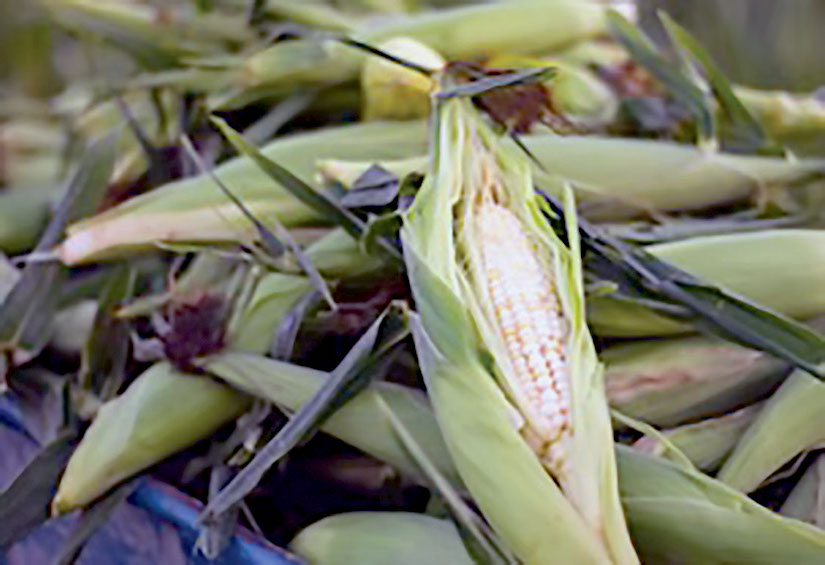Sweet Corn in the Home Garden
go.ncsu.edu/readext?1080908
en Español / em Português
El inglés es el idioma de control de esta página. En la medida en que haya algún conflicto entre la traducción al inglés y la traducción, el inglés prevalece.
Al hacer clic en el enlace de traducción se activa un servicio de traducción gratuito para convertir la página al español. Al igual que con cualquier traducción por Internet, la conversión no es sensible al contexto y puede que no traduzca el texto en su significado original. NC State Extension no garantiza la exactitud del texto traducido. Por favor, tenga en cuenta que algunas aplicaciones y/o servicios pueden no funcionar como se espera cuando se traducen.
Português
Inglês é o idioma de controle desta página. Na medida que haja algum conflito entre o texto original em Inglês e a tradução, o Inglês prevalece.
Ao clicar no link de tradução, um serviço gratuito de tradução será ativado para converter a página para o Português. Como em qualquer tradução pela internet, a conversão não é sensivel ao contexto e pode não ocorrer a tradução para o significado orginal. O serviço de Extensão da Carolina do Norte (NC State Extension) não garante a exatidão do texto traduzido. Por favor, observe que algumas funções ou serviços podem não funcionar como esperado após a tradução.
English
English is the controlling language of this page. To the extent there is any conflict between the English text and the translation, English controls.
Clicking on the translation link activates a free translation service to convert the page to Spanish. As with any Internet translation, the conversion is not context-sensitive and may not translate the text to its original meaning. NC State Extension does not guarantee the accuracy of the translated text. Please note that some applications and/or services may not function as expected when translated.
Collapse ▲What is better than eating a fresh ear of sweet corn in the summer? Whether it be white kernels, yellow kernels or bicolor the taste of warm sweet corn on the cob with butter is hard to beat.
Corn is in the grass family, Poaceae with other grain crops such as wheat, rice, millet and sorghum. Compared to field corn, sweet corn has a higher sugar content. Most of the sweet corn grown today are hybrids that are cross-bred and selected for the best qualities. There are also different genetic types such as “su”, “se”, “sh”, or “syn”.
Sugary (“su”) varieties lose close to half their sugar content in 24 hours and are best eaten the day they are harvested or the next day. An example of this is the old favorite Silver Queen.
Sugar Enhanced (“se”) had a higher sugar content and a longer shelf life (3-4 days in the refrigerator). Kandy Korn, Silver Kind and Bodacious are examples of sugary enhanced varieties.

Supersweet (“sh2”) varieties have three times the sugar content of su and se types. A gene that slows the conversion of sugar to starch helps retain their sweetness longer (7-8 days). Honey ‘n Pearl, Glacial and Passion are reliable varieties. Triplesweet (“syn”) combines the sweetness genes of se, sh2, and su for high sugar content and storability. Honey Select, Milky Way and Temptress are examples of good varieties.
Sweet corn is pollinated by wind and can easily cross pollinate with other corn crops tasseling at the same time. If multiple plantings of sweet corn are intended then make sure to plant the different varieties at least 14 days apart. The key is to see how long it will take each variety to mature. Most sweet corn varieties will take 80-90 days before harvest.
Corn seeds need a soil temperature close to 65 degrees F to germinate. Corn is a heavy feeder that does well in moist, fertile soils. It does best at a pH of 5.8-6.2. It is always recommended to do a soil test, but in the absence of a soil test apply two cups of a complete fertilizer like 10-10-10 per 10-foot of row. When plants are two feet tall supplement with a nitrogen fertilizer (34-0-0) as a side dress. Examples of organic fertilizer include blood meal, bone meal, fish emulsion or composted animal manure. Plant seeds 9-12 inches apart and about 1 inch deep.
Hot weather and drought can cause poor pollination during tasseling thus leading to undeveloped, poorly filled ears. When planting be sure to plant corn in at least 4-5 rows wide to optimize pollination by wind.
The main pests of sweet corn occur later in the season. Common pests include flea beetles, European corn borer and corn earworm.
Harvest sweet corn when the silks have dried and turned brown. The quicker you harvest the tender the kernels. Refrigerate as quick as possible down to 40 degrees F to eat later.
For more information about sweet corn, or if you have other gardening questions, feel free to contact the N.C. Cooperative Extension, Franklin County Center at 919-496-3344. Stay tuned for nutritional information about sweet corn in the next Growing in Franklin article.




